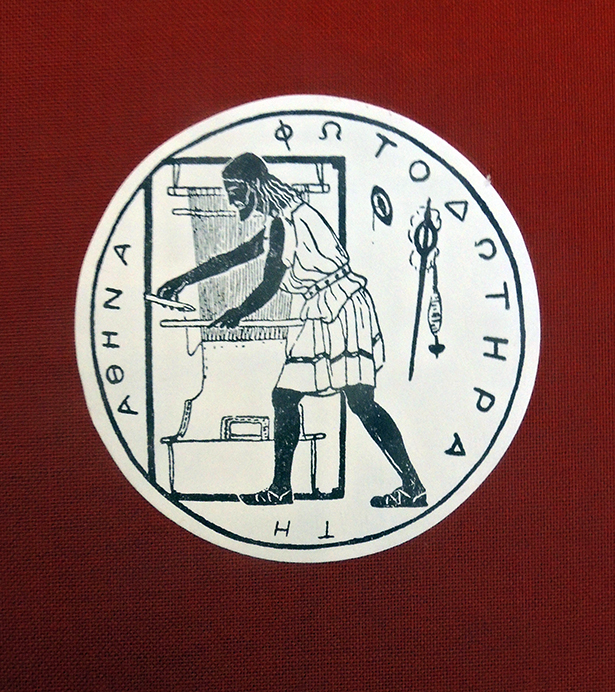
The printing press of Raymond Duncan, visited by Orson Welles:
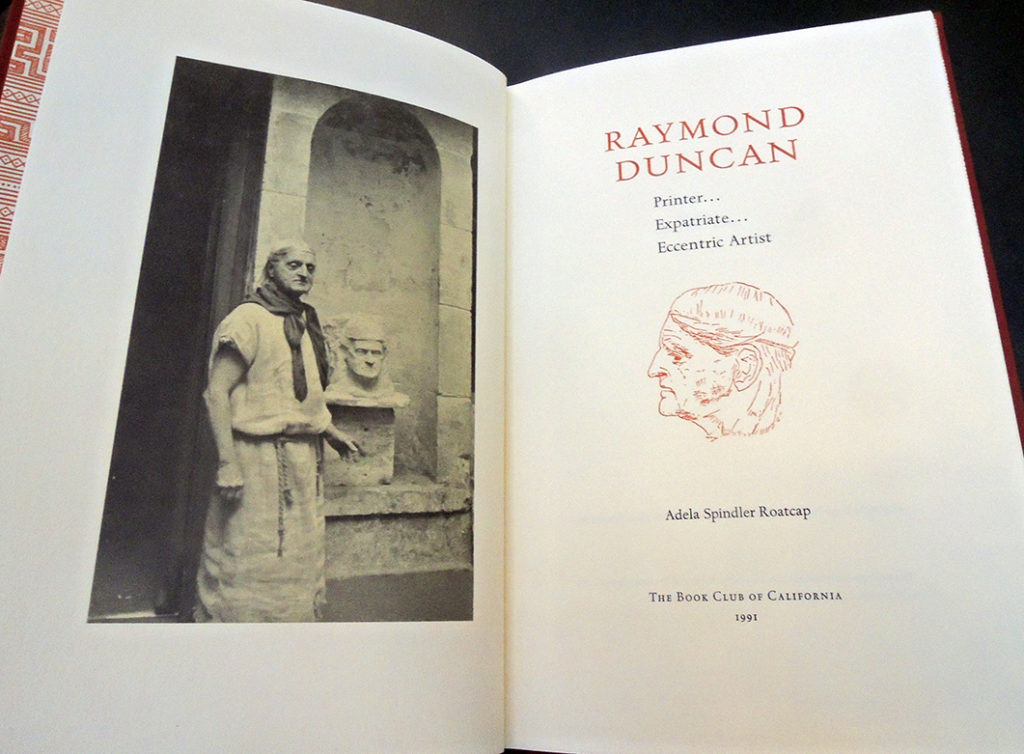
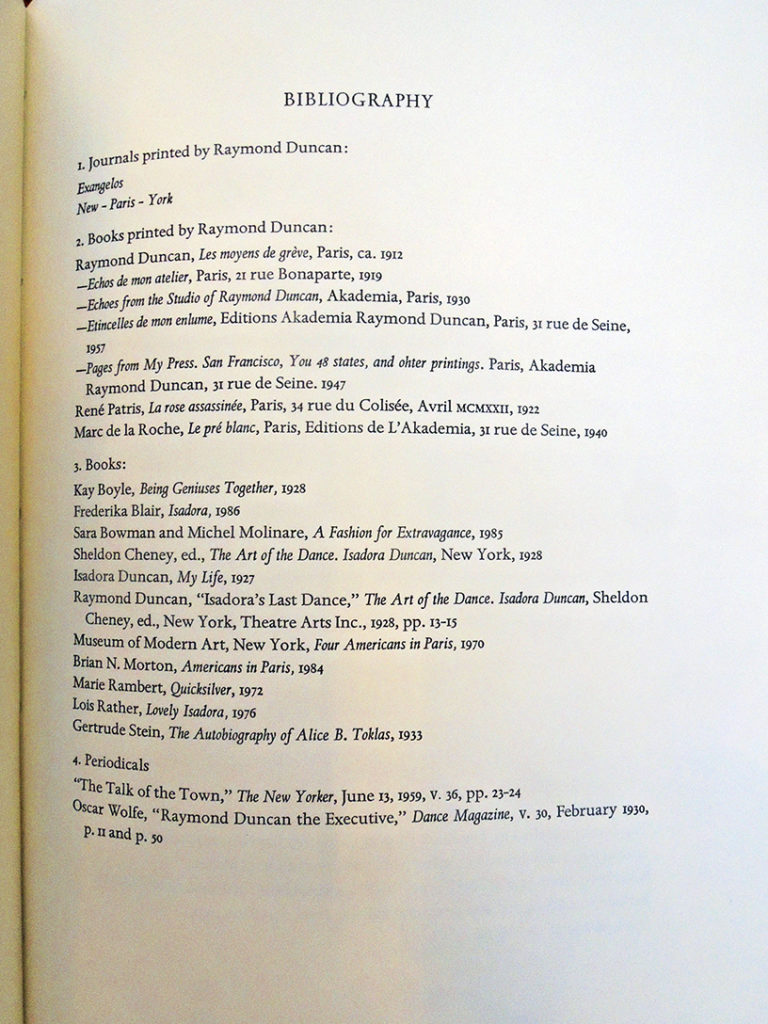 Coming soon to Princeton University Library, the books of Raymond Duncan.
Coming soon to Princeton University Library, the books of Raymond Duncan.

The Graphic Arts Collection recently acquired two portfolios by the wonderful Puerto Rican artist Nelson Sambolín (born 1944). The first is De Olimpia a Mayagüez: Portfolio Conmemorativo de los X Juegos Centroamericanos y del Caribe celebrados en Mayagüez, Puerto Rico en el año 2010. (Puerto Rico: Proyecto Om.; printed by Luis Maisonet, José (Pepe) Ibañez, and Nelson Sambolín, 2010).
De Olimpia a Mayagüezincludes 2 unnumbered leaves with an essay by Edgardo Rodríguez Juliá (born 1946) and 12 screen prints, 50 x 70 cm, produced by Proyecto Om, Inc. in commemoration of the XXI Central American and Caribbean Games, officially endorsed by the Mayagüey Committee 2010. Princeton holds copy 145/200, a few examples shown here:
Our second acquisition celebrates the 2009 bicentenary of Edgar Allan Poe’s birth, when the Editorial Universidad de Puerto Rico published a new edition of what is considered the best Spanish translation of his writing, entitled Edgar Allan Poe Obras en Prosa I & II. (Firestone Library PS2612 .C6 1956). The translation by the Argentine writer Julio Cortázar (1914-1984) was first published in 1956, commissioned by the University of Puerto Rico at the request of Francisco Ayala, the first editor of La Editorial.
Nelson Sambolín designed the graphic illustrations for this two-volume set and also produced a separate portfolio of 12 monumental linocuts entitled Grabados a Poe. The Graphic Arts Collection holds copy 7/10, a few shown here:
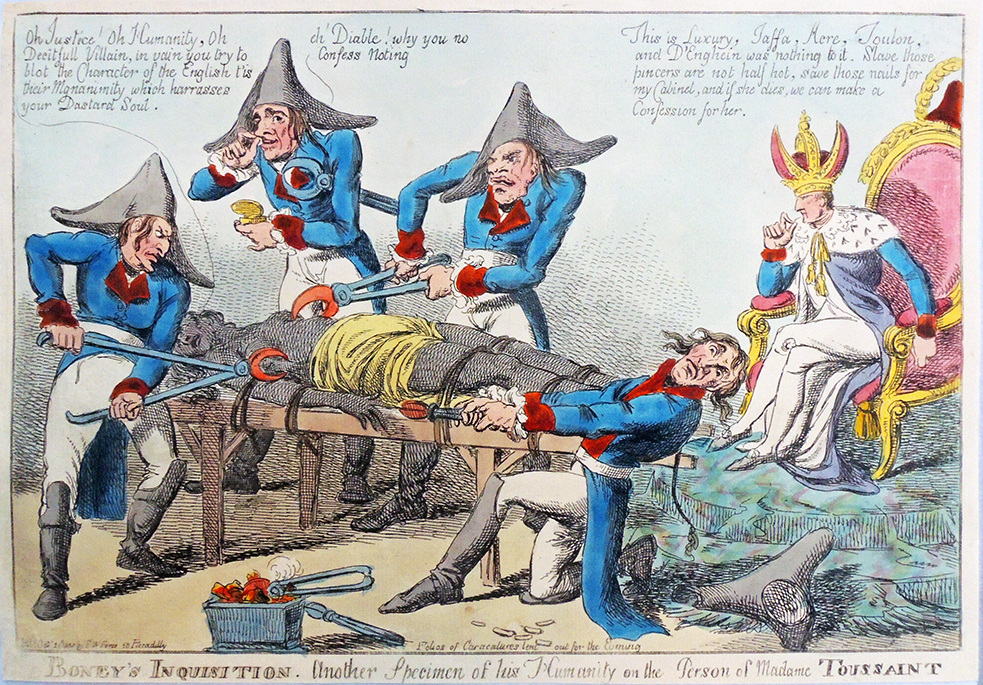 After Charles Williams, Boney’s Inquisition.Another Specimen of his Humanity on the Person of Madame Toussaint. London: ‘Pubd. Octr. 25th 1804 by by S.W. Fores, 50 Piccadilly’, 1804. Hand colored etching. Graphic Arts Collection GAX 2020- in process
After Charles Williams, Boney’s Inquisition.Another Specimen of his Humanity on the Person of Madame Toussaint. London: ‘Pubd. Octr. 25th 1804 by by S.W. Fores, 50 Piccadilly’, 1804. Hand colored etching. Graphic Arts Collection GAX 2020- in process
“One of the greatest Wars of Independence ever fought in history was the Haitian Revolution (1791-1804), led by the ‘immortal’ black leader Toussaint Louverture, who became a General in the French military, and whose destiny it was to deliver the slaves and people of Saint Domingue, now Haiti.” Suzanne Simone Baptiste Louverture (1742?-1816), the wife of Toussaint Louverture (1743?-1803), was arrested with her husband during the Haitian revolution in 1802.
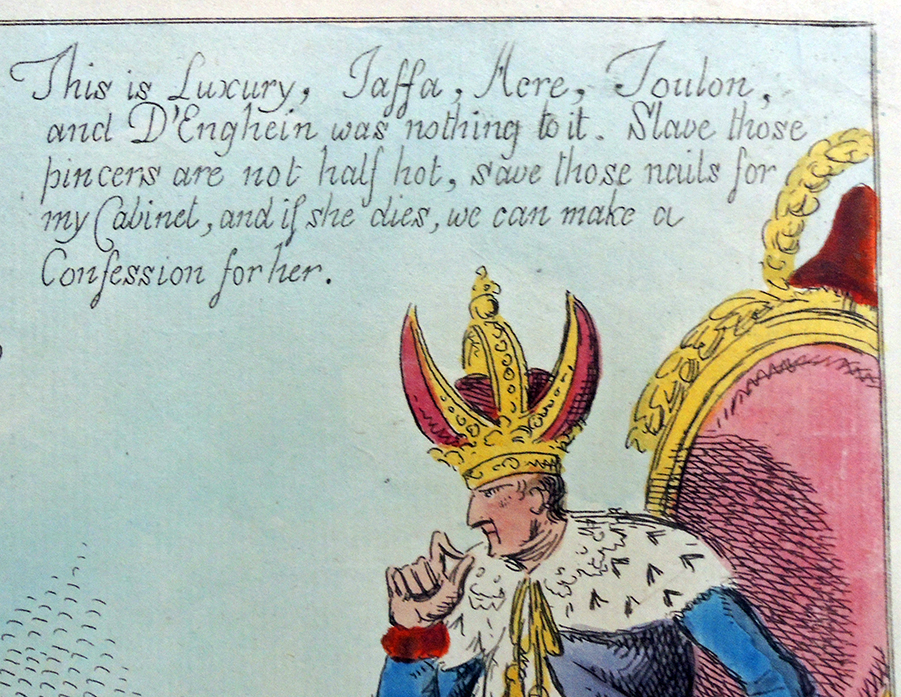 Napoleon Bonaparte sent General Charles Leclerc to apprehend Louverture and deport him to the French Alps. Suzanne and her children were transported to Bayonne, where they were placed under the supervision of General Ducos. She was tortured but never provided any information about her husband. One source notes, “When she arrived in prison she weighed 250 pounds; she only weighed 90 when leaving France. During all the years of torture she gave a single answer. ‘I will not talk about my husband’s business with his torturers.’ It was a mutilated Suzanne, a purely vegetative Suzanne, devoid of all her nails, with several broken bones, who returned to Jamaica where she died on May 19, 1846. She was 67 years old.”
Napoleon Bonaparte sent General Charles Leclerc to apprehend Louverture and deport him to the French Alps. Suzanne and her children were transported to Bayonne, where they were placed under the supervision of General Ducos. She was tortured but never provided any information about her husband. One source notes, “When she arrived in prison she weighed 250 pounds; she only weighed 90 when leaving France. During all the years of torture she gave a single answer. ‘I will not talk about my husband’s business with his torturers.’ It was a mutilated Suzanne, a purely vegetative Suzanne, devoid of all her nails, with several broken bones, who returned to Jamaica where she died on May 19, 1846. She was 67 years old.”
According to records, the print is correct in the pulling of her fingernails and other tortures.
–PBS Egalite for All: Toussaint Louverture and the Haitian Revolution (2009)
Suzanne Louverture was still living when the British artist Charles Williams (active 1796-1830) published this print. It is not unusual that the artist did not sign the print, Williams often worked anonymously and it is only in recent years that earlier attributions have been reconsidered.
Toussaint Louverture and the Haitian Revolution inspired millions of free and enslaved people to seek freedom and equality throughout the Atlantic world. His legacy continues to inspire artists and politicians today. One of many examples is the series Jacob Lawrence produced entitled “The Life of Toussaint Louverture”:
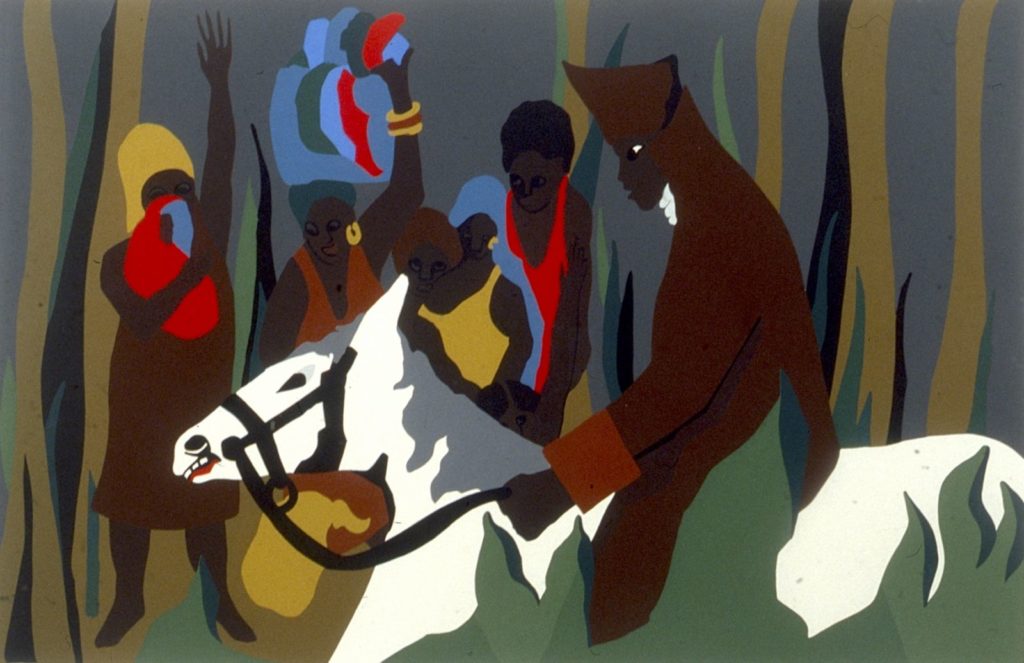
For more, read Temi Odumosu, Africans in English caricature 1769-1819: Black Jokes, White Humour (London: Harvey Miller Publishers, [2017]). Marquand Library NC1473 .O38 2017 and see: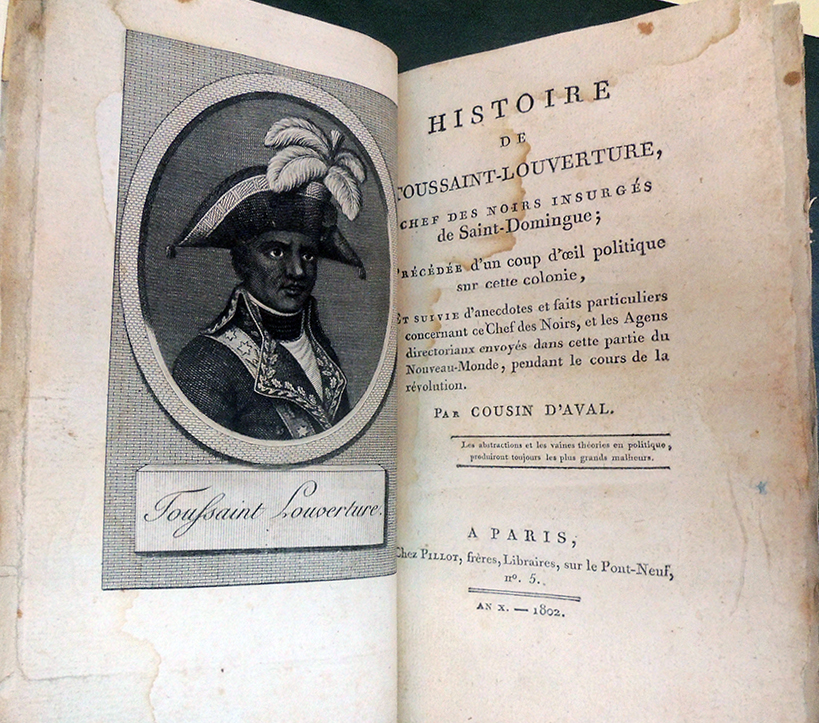
 Note: this horrific print is one of the caricatures Samuel Fores lent out for an evening’s entertainment in your own home.
Note: this horrific print is one of the caricatures Samuel Fores lent out for an evening’s entertainment in your own home.
The Rev. Ernesto Cardenal, one of Latin America’s most admired poets and priests, who defied the Roman Catholic Church in the 1980s by serving in the revolutionary Sandinista government of Nicaragua, died on Sunday in Managua, Nicaragua. He was 95.
His personal assistant, Luz Marina Acosta, confirmed his death to The Associated Press.
Born to a wealthy Nicaraguan family, Father Cardenal became a prominent intellectual voice of the Nicaraguan revolution and an ardent proponent of liberation theology, a Christian movement rooted in Marxist principles and committed to social justice and uplifting the poor. He was appointed Nicaragua’s first minister of culture after the Sandinistas overthrew the dictator Gen. Anastasio Somoza Debayle in 1979.
As the Vatican’s opposition to liberation theology intensified in the 1980s under Pope John Paul II, Father Cardenal became a focal point. Before a scheduled visit to Nicaragua in 1983, the pope publicly demanded that Father Cardenal and four other priests who had actively supported the revolution resign their government positions. The Sandinista government refused the demand to replace them, but said its invitation to the pope still stood.
After months of public arguing, the pope accepted the invitation and landed in Managua, Nicaragua’s capital. As he walked along a receiving line on the tarmac shaking hands, the pope seemed taken aback to see Father Cardenal among the dignitaries.
While other priests were in clerical garb, Father Cardenal had shown up wearing a collarless white shirt, slacks and his signature black beret over his thick white hair. When he knelt to kiss the pope’s ring, the pope withheld his hand and wagged his finger at him as he spoke to him, apparently sternly. According to a Vatican official, the pope told Father Cardenal, “You must straighten out your position with the church,” The Associated Press reported.–Elias E. Lopez New York Times March 1, 2020 https://www.nytimes.com/2020/03/01/world/americas/ernesto-cardenal-dead.html
Thanks to a successful Kickstarter campaign, P22 Publications released Savage Impressions: An Aesthetic Expedition Through the Archives of Independent Project Records & Press, founded by Bruce Licher. The Graphic Arts Collection just received one of the 350 deluxe editions that include: 12” gold vinyl record titled Tape Excavation consisting of previously unreleased recordings spanning Bruce Licher’s recording career (1980-2019); special letterpress-printed stamp sheet tipped into the book; perforated chipboard letterpress bookplate tipped in, signed and numbered by Bruce Licher; and a letterpress wrap sleeve to hold the book and record together as a set.
Bruce Licher founded Independent Project Press in 1982 after learning the art of letterpress printing at the Women’s Graphic Center in downtown Los Angeles. His initial projects centered around creating album covers, postcards and promotional stamps for his band Savage Republic and for releases on his Independent Project Records label. It didn’t take long before he was producing work for other L.A. underground music groups, along with a growing number of clients in the Los Angeles design community and an array of better-known musicians such as R.E.M, Harold Budd, and Stereolab.
Licher continues to translate his signature artistic design aesthetic to other products: book, magazine, catalog design, elegant and creative business stationery, wedding invitations, wine labels, promotional stamp sheets and booklets, and other letterpress-printed ephemera for clients large and small.
Licher currently works out of his studio on WIllow Street in the Eastern Sierra town of Bishop, California.–https://info701245.wixsite.com/mysite-5/bruce-licher
https://www.kickstarter.com/projects/p22/savage-impressions-the-book
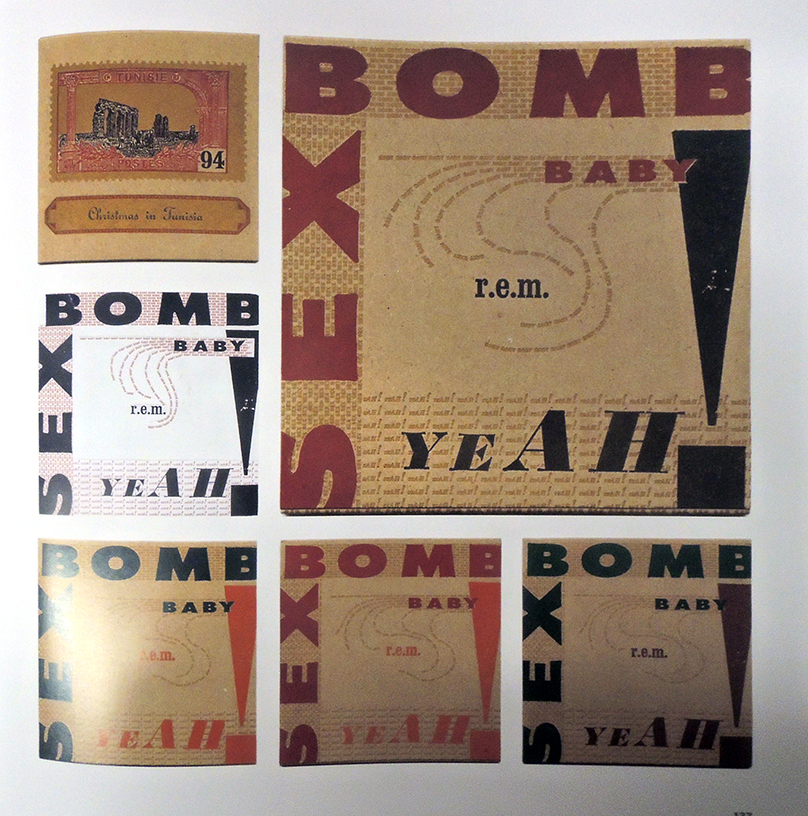 Savage impressions: an aesthetic expedition through the archives of Independent Project Records & Press, compiled by Bruce Licher and Karen Nielsen Licher. Deluxe edition (Rochester, NY : P22 Publications, 2020). Graphic Arts Collection GAX 2020- in process
Savage impressions: an aesthetic expedition through the archives of Independent Project Records & Press, compiled by Bruce Licher and Karen Nielsen Licher. Deluxe edition (Rochester, NY : P22 Publications, 2020). Graphic Arts Collection GAX 2020- in process
The Graphic Arts Collection recently acquired the original copper plates for six of Edwin Landseer’s juvenile etchings made between the ages of 8 and 10, including his first etching and a previously unpublished and unrecorded plate. These came along with the 1974 re-strikes of five of the plates and a new impression of the unrecorded sixth plate [above]. The plates are clear and the images visible, even though the photography here might not appear to be.
Here is the full description of the plates, transcribed exactly from Roger Gaskell’s excellent research:
1. Heads of Sheep and Cattle, 1810. Lettering: Edwin Landseer, del & sculp. in his 8th year. London: Published Nov.r 8.th 1852 by P.& D. Colnaghi &Co. 13 & 14 Pall Mall, East.
180 x 116 x 1.19mm rounded corners, makers name ‘I. Shafe Shoe-Lane London’ stamped on the back. Scratched number 18 and circular scoring on the back. Graves 3; BM 1853,0409.27 (an unlettered proof inscribed ‘EL delt & sculp in his 8th year’); RCIN 815000.
2. Heads of a Boar, Sheep, and Donkey, 1810. Lettering: Edwin Landseer, del. & Sculp. his 1st Etching executed in his 8th year.
114 x 178 x 1.38mm, bevelled edges, rounded corners, makers name ‘G. Harris No 31 Shoe Lane London’ stamped on the back. Three etched figures, described below, scratched number 16 and oblique scoring on the back. Graves 4; BM 1853,0409.30 (unlettered proof inscribed ‘Edwin Landseer delt & sculp – his first etching in his 8th year’); RCIN 815001. [On the back of the plate in upright orientation:]
2b A Cow and two Lambs’ Heads. This must always have been intended as a trial because the image is close to the stamped name of the plate maker and would be difficult to print without taking an impression of the stamp. There are a few scratches as can be seen in 1974 re-strike. Unknown to Graves.
3. A Horse, Goat and Bull, 1811 Lettering: Edwin Landseer, del & sculp. London: Published Nov.r 8.th
198 x 121 x 1.5mm, bevelled edges, rounded corners, makers name ‘G. Harris No 31 Shoe Lane London’ stamped on the back. Scratched number 17 on the back. Graves 5; BM 1853,0409.25 (unlettered proof inscribed ‘E. Landseer delt & sculp’); RCIN 815002.
4. Donkeys and a Foal, 1811 Lettering: Edwin Landseer, del. in his 9th year. T. Landseer, sculp. London: Published Nov.r 8.th 1852 by P.& D. Colnaghi &Co. 13 & 14 Pall Mall, East.
129 x 115 x 1.43mm, rounded corners, makers name ‘G. Harris No 31 Shoe Lane London’ stamped on the back. Scratched number 11[?] and oblique scoring on the back. Graves 6; BM 1853,049.26 (unlettered proof inscribed at left beside top donkey ‘EL, Delt & Sculp’ and blow image ‘EL’ at left and ‘TL’ at right); RCIN 815002. The legend on the plate ascribes the etching to Thomas Landseer (1795–1880), Edwin’s the elder brother but Graves ascribes it to Edwin Landseer. In fact they both had a hand, the pencilled inscription on the BM impression indicating that the etching of the donkey at the top was done by Edwin and the donkey and foal below by Thomas Landseer.
5. A Cow and Calf, 1812 Lettering: Edwin Landseer, del & sculp. in his 10th year. London: Published Nov.r 8.th 1852 by P.& D. Colnaghi &Co. 13 & 14 Pall Mall, East.
127 x 179 x 1.5mm, bevelled edges, rounded corners, makers name ‘G. Harris No 31 Shoe Lane London’ stamped on the back. Scratched number 6 on the back. Graves 9; not in BM. RCIN 815003 (an early state); RCIN 815004 (published by Colnaghi 1852).
6. Two Rams’ Heads, no imprint, c. 1810-12 No lettering.
204 x 167 x 1.31mm, edges bevelled on the back, rounded corners. ‘Landseer’ and ‘15’ scratched on the back. Maker’s name ‘G. Harris No 31 Shoe Lane London’. Punched on the back half way down on the right hand side, perhaps for an erasure as there is no etching on the face at this point. Although unsigned, the style of the plate, its survival with Landseer’s other juvenile etchings and the scratched name on the back leave little doubt that this is his work and thus a new addition to his oeuvre. Unknown to Graves; no impressions located.
The plates were probably not have been published in Landseer’s youth. By 1852 they were in the possession of Peter and Dominic Colnaghi who published restrikes of five of them with new lettering identifying the artist and adding their imprint. These prints are very rare so the edition was probably small. Predictably there are impressions in the Royal Collection. The British Museum holds rather messy unlettered proofs of four of the plates, probably the artist’s proofs with pencil lettering which is evidently the source of the lettering added by Colnaghi, who sold the proofs to the Museum in 1853. The sixth plate is not lettered, though it has Landseer’s name scratched on the back, and there no proof in the BM.
In the 1970s (or before) the plates came into the hands of the publisher, printing historian and Bewick scholar Iain Bain (1934-2018). Bain printed an edition of 80 copies (75 for sale) of the five etchings issued by Colnaghi and these were offered to subscribers in a portfolio with a brief introduction at £80 plus VAT. Pre-publication subscribers received a bonus of ‘an additional print taken from the back of one of the plates which carries three experimental studies never before published’. A copy of the publication, including the bonus print and the prospectus, is offered here with the plates. The sixth plate, which as noted above is unknown from contemporary or later impressions, is accompanied by a recent impression.
Edwin Henry Landseer (1802–1873). Six etched copper plates, 1810–1812 (legends and imprint lines were added to five plates in 1852) [with] Iain Bain, The childhood etchings of Sir Edwin Landseer, R.A. Five prints taken from his still surviving copper plates: etched between his 8th and 10th years c. 1810–1812. Produced for The Heritage Collection by Iain Bain at the John Boydell Press MCMLXXIV. (Bristol: The Heritage collection, 1974.) 6 prints in the original buckram portfolio. Together with the prospectus, also dated 1974, five 1974 re-strikes of the plates and a new impression of the unrecorded sixth plate. Graphic Arts Collection GAX 2020- in process.
*CDV portrait from the Laurence Hutton Photograph album Box 3.
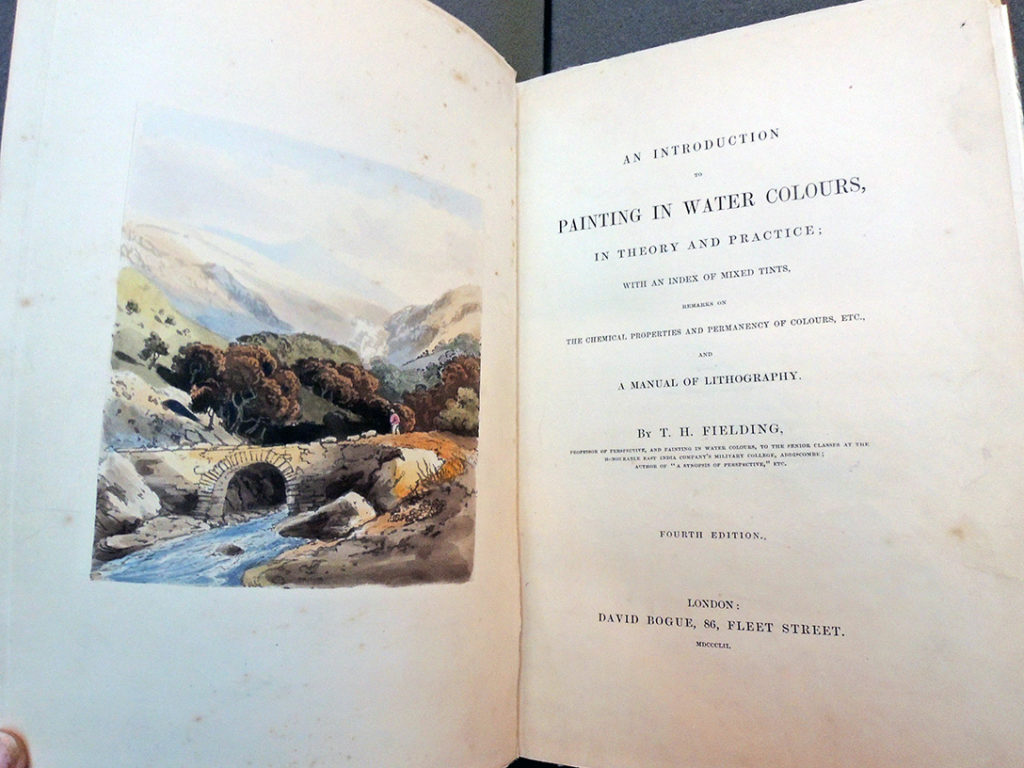
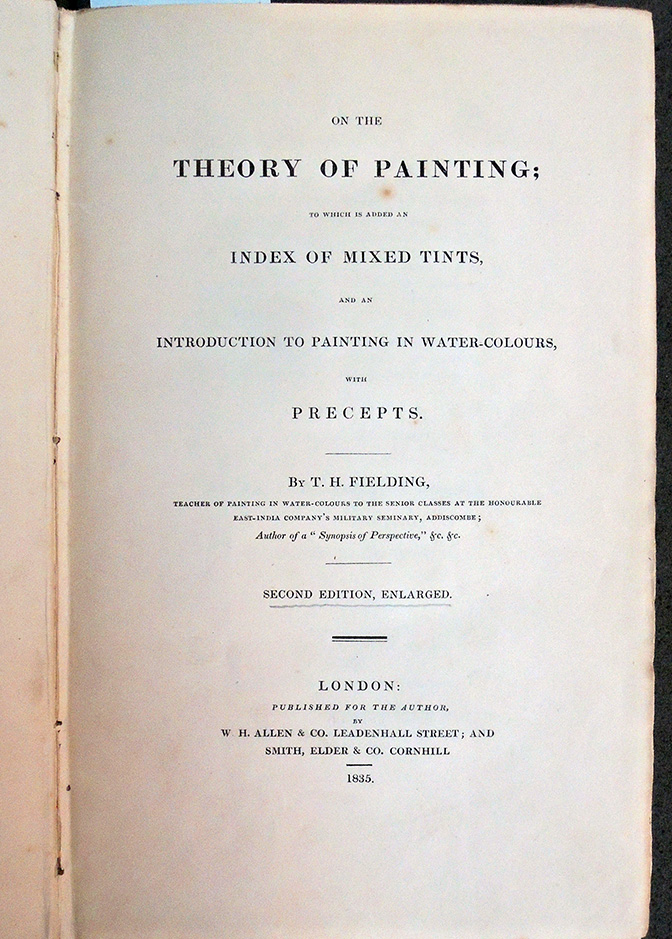 Theodore Henry Adolphus Fielding (1781-1851), the elder son of Nathan Theodore Fielding, was a painter, printmaker, and teacher. He published collections of landscapes in aquatint such as: A Picturesque Tour of the English Lakes (1821), Picturesque Illustrations of the River Wye (1822), and Cumberland, Westmoreland and Lancashire Illustrated (1822).
Theodore Henry Adolphus Fielding (1781-1851), the elder son of Nathan Theodore Fielding, was a painter, printmaker, and teacher. He published collections of landscapes in aquatint such as: A Picturesque Tour of the English Lakes (1821), Picturesque Illustrations of the River Wye (1822), and Cumberland, Westmoreland and Lancashire Illustrated (1822).
Beginning in 1830, while still a painting instructor to the “senior classes at the Honourable East-India Company’s military Seminary” at Addiscombe, Surrey, Fielding began publishing manuals on painting, perspective, and art theory. In particular, his expertise on mixing color pigments was beautifully documented in physical sample of brightly printed color, as seen here.
The books were so popular and went through so many editions that it is often difficult to put dates to them. For instance, there were “enlarged, 2nd editions” of his On the Theory of Painting in both 1835 and 1836. Thanks to the generous donation of Dickson Q. Brown, Princeton Class of 1895, the Graphic Arts Collection has two now rare examples:
Theodore Henry Fielding (1781-1851), An introduction to painting in water colors: in theory and practice: with an index of mixed tints, remarks on the chemical properties and permanency of colours, etc., and a manual of lithography (London : D. Bogue, 1852). Graphic Arts Collection Rowlandson 671.2
Theodore Henry Fielding (1781-1851), On the theory of painting; to which is added and index of mixed tints, and an introduction to painting in water-colours, with precepts (London, W.H. Allen, 1836). Graphic Arts Collection Rowlandson 671
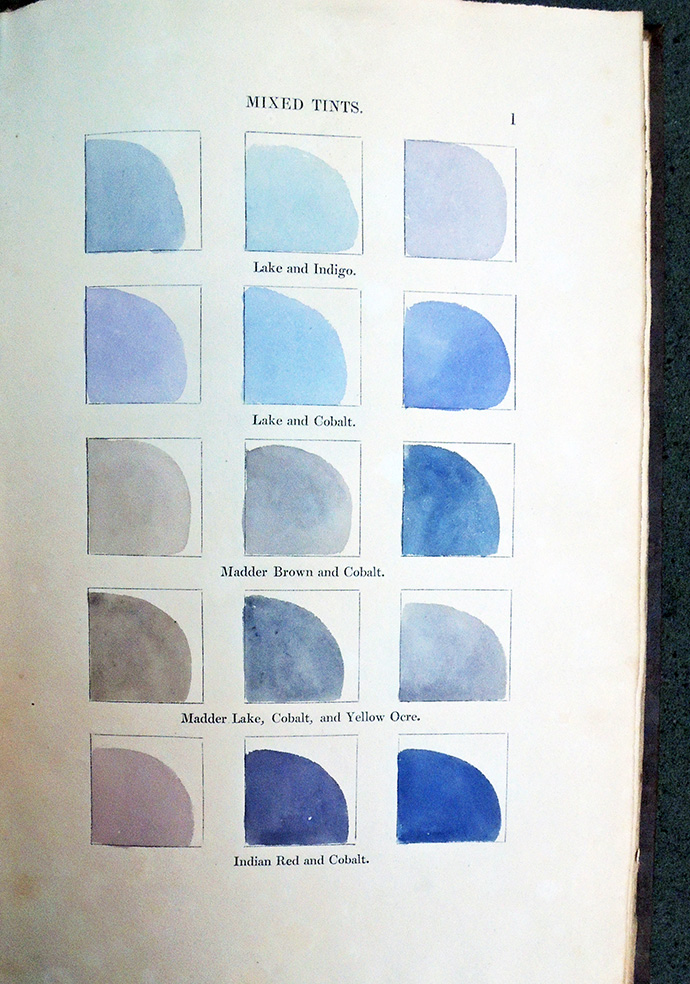 Fielding included this quote from Sir Joshua Reynolds on the title page of many of his volumes: “The rules of art are not the fetters of genius, they are fetters only to men of no genius.”
Fielding included this quote from Sir Joshua Reynolds on the title page of many of his volumes: “The rules of art are not the fetters of genius, they are fetters only to men of no genius.”
Of the nature of colours, nearly all we know is, that they exist in various tinted rays, which combined make pure or colourless light. Could the artist be made acquainted with their physical or first cause, and how objects receive their colours, he might obtain some advantages, for they are not so splendidly and lavishly displayed throughout the works of Nature without some great meaning, otherwise their existence would seem only for our amusement instead of instruction.
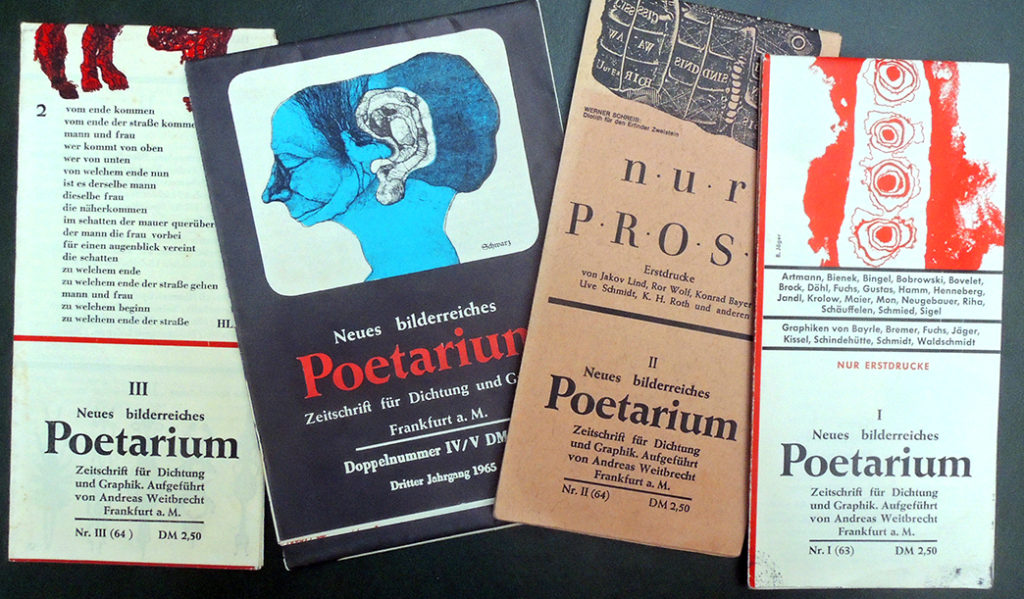 Andreas Weitbrecht, editor. Neues bilderreiches Poetarium. Zeitschrift für Dichtung und Graphik. (Frankfurt am Main: Andreas Weitbrecht, 1963-65). (42 x 59 cm; 63 x 59 cm; 59 x 83 cm). 5 issues in 4 posters. Graphic Arts Collection 2020- in process
Andreas Weitbrecht, editor. Neues bilderreiches Poetarium. Zeitschrift für Dichtung und Graphik. (Frankfurt am Main: Andreas Weitbrecht, 1963-65). (42 x 59 cm; 63 x 59 cm; 59 x 83 cm). 5 issues in 4 posters. Graphic Arts Collection 2020- in process
The Graphic Arts Collection recently acquired a complete set of Poetarium, a rare German “magazine for poetry and graphics” edited by Andreas Weitbrecht. Some of the major writers included over the three years it was published are A.C. Artmann, Johannes Bobrowski, Bazon Brock, Ernst Jandl, Karl Krolow, Friederike Mayröcker, Christoph Meckel, Franz Mon, and Ror Wolf. The graphic artists include Thomas Bayrle, Uwe Bremer, Günter Bruno Fuchs, Bernhard Jäger, Ali Schindehütte, Arno Waldschmidt and many others. The final double number folds out to a wonderful poster by Bayrle and Jäger [above].
Read more about the publication in Bernhard Fischer, Deutsche literarische Zeitschriften, 1945-1970 : ein Repertorium. herausgegeben vom Deutschen Literaturarchiv, Marbach am Neckar (München ; New York : K.G. Saur, 1992). Germanic Languages Graduate Study Room (SD) Oversize Z2225 .F572 1992q. pp. 575-6, no. 818. Every artist and writer presented over the three years is listed here:
In 1839, Georg Büchner published Lenz, a ground-breaking novella about schizophrenia. In 2020, Ines von Ketelhodt designed and published Mienenspiel, incorporating sections of Büchner’s text onto its reflective pages, placing the reader/viewer in the uncomfortable position of being outside and inside the book at the same time.
The artist writes: “The book investigates the wide range of human facial expressions and the topic of facial recognition. Thanks to the mirror effect of the paper, which is coated in silver foil, viewers see themselves in the book as they turn the pages. They can imitate the illustrations of facial expressions that are printed on the foil, and modify their reflected images accordingly. The text passages from Georg Büchner’s Lenz (1839) describe “all the subtle, barely noticed play of facial features,” “the human nature,” respect and tolerance for individuals, the “unique existence of each being,” as well as Medusa’s head.”
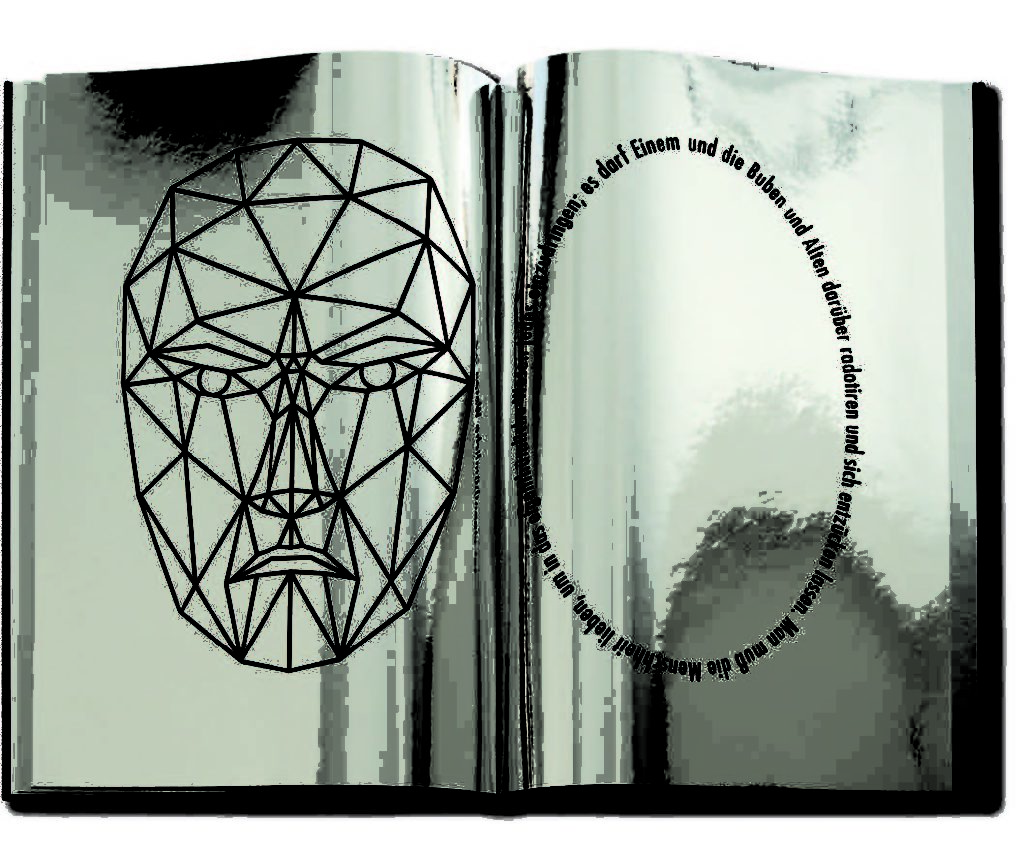 The original German text is printed on each right-hand page, with an English translation on the left. The texts are set around an oval shape that is reminiscent of a mirror or even a face. Viewers can read the text by turning the book counter-clockwise. This also changes the reflected surroundings of the double-page spread.
The original German text is printed on each right-hand page, with an English translation on the left. The texts are set around an oval shape that is reminiscent of a mirror or even a face. Viewers can read the text by turning the book counter-clockwise. This also changes the reflected surroundings of the double-page spread.
The face illustrations and texts are letterpress printed with polymer plates on Chromolux paper, which is coated on one side with aluminum. The reverse and uncoated side of the papers are glued together along the front edge.
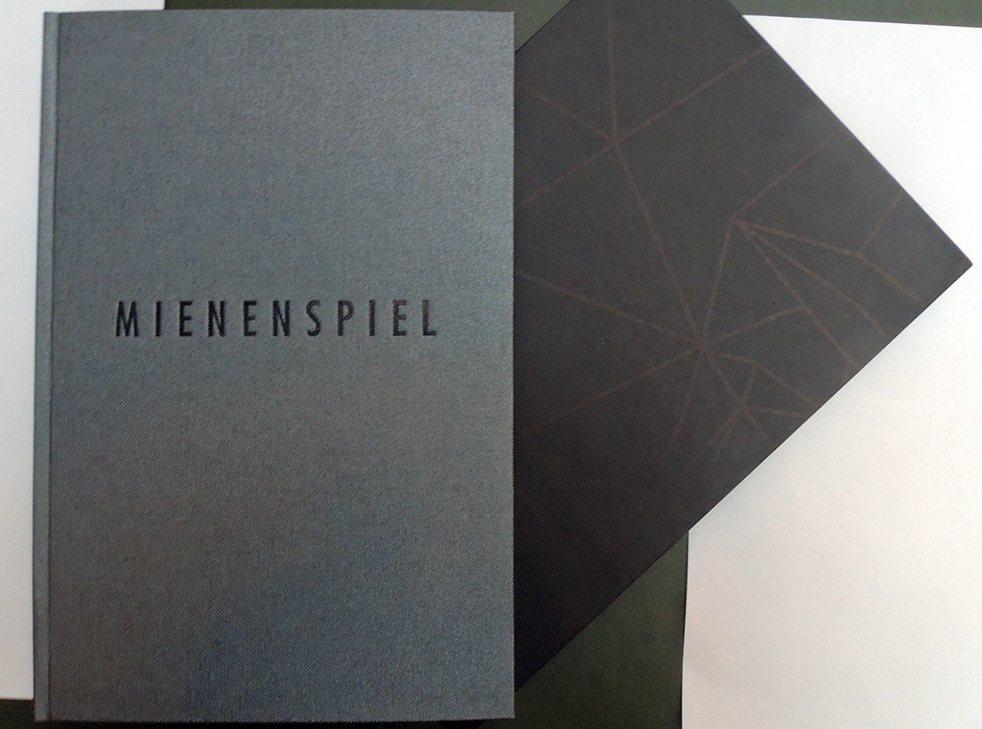 Ines von Ketelhodt, designer, printer, and bookbinder, Mienenspiel (Flörsheim, Germany: Ines von Ketelhodt, 2020). Graphic Arts Collection GAX 2020-in process. 40 p., embossed cloth-covered boards housed in a paper-covered slipcase, 35 numbered and signed copies. von.ketelhodt@k-und-m-design.de; www.tloen-enzyklopaedie.de
Ines von Ketelhodt, designer, printer, and bookbinder, Mienenspiel (Flörsheim, Germany: Ines von Ketelhodt, 2020). Graphic Arts Collection GAX 2020-in process. 40 p., embossed cloth-covered boards housed in a paper-covered slipcase, 35 numbered and signed copies. von.ketelhodt@k-und-m-design.de; www.tloen-enzyklopaedie.de
The German dramatist and novelist Georg Büchner (1813-1837) died at the sadly young age of twenty-four, leaving the question of what he might have accomplished had he lived longer. In 1828 he became interested in politics and joined a group which later on probably became the Gießen and Darmstadt section of the “Gesellschaft für Menschenrechte” (Society for Human Rights). In 1835, his first play, Dantons Tod (Danton’s Death) about the French revolution was published, followed by Lenz, a novella based on the life of poet Jakob Michael Reinhold Lenz.
His unfinished and most famous play, Woyzeck, was the first literary work in German whose main characters were members of the working class. Published after Büchner’s death, it became the basis for Alban Berg’s opera Wozzeck, which was first performed in 1925.–[Wikipedia]
Lenz, Georg Büchner’s visionary exploration of an 18th-century playwright’s descent into madness, has been called the inception of European modernist prose. Elias Canetti considered this short novella one of the decisive reading experiences of his life, and writers as various as Paul Celan, Christa Wolff, Peter Schneider, and Gert Hofmann have paid homage to it in their works.
Published posthumously in 1839, Lenz provides a taut case study of three weeks in the life of schizophrenic, perhaps the first third-person text ever to be written from the “inside” of insanity. An early experiment in docufiction, Büchner’s textual montage draws on the diary of J.F. Oberlin, the Alsatian pastor who briefly took care of Lenz in 1778, while also refracting Goethe’s memoir of his troubled friendship with the playwright.”– https://archipelagobooks.org/book/lenz/
Artist statement: “Ines von Ketelhodt studied Visual Communication at the University of Art and Design in Offenbach, Germany. Since 1986 she works in the fields of photography, typography, artist’s books, and graphic design. She was a co-founder of the book artists’ collective Unica T (1986–2001). From 1997 to 2006 she worked together with Peter Malutzki on the fifty volumes book art project Zweite Enzyklopädie von Tlön. In 2002 she moved to Flörsheim, Germany and opened a joint workshop with Peter Malutzki. Her main interests include: experimental typography; experimental photography (such as long exposure time, taking photographs by chance); combination of photography and typography; combination of old and new techniques (such as letterpress, original photographic prints, offset and digital printing).”
Princeton students, we now also have access to the 1982 film by Alexandre Rockwell, an adaptation of Lenz, transposed from 18th century Germany to New York in the early 1980s. https://www.kanopy.com/product/lenz
Here are a few of the materials pulled for the upcoming writing seminar “Living with AI” led by instructor William Penman and assisted by Anu Vedantham, assistant university librarian for research services. The students will compare early 19th and 20th-century technology with contemporary ways we are “searching YouTube, unlocking our phones with our faces, seeing advertising on Facebook, asking Siri to turn up the music . . . actively and passively use artificial intelligence (AI) daily. How does AI promise new kinds of interactions? Why are some industries turning to AI while others are not? How are the risks and benefits of AI shaping the future design of these technologies?”
Both fiction and non-fiction texts are being considered, including the definitive 20th-century car book, The Great Gatsby.
F. Scott Fitzgerald, “The cruise of the rolling junk,” in Motor (New York, N.Y.) Vol. 41, no. 3-5 (Feb.-Apr., 1924). Oversize 2003-0046F. “Beginning an adventure in motoring by the author of “This side of paradise.” — Pt. 1. “The modern argonauts, the author and his wife, in a battered Expenso, are en route from Westport, Connecticut, to the family homestead in Alabama. … ” — Pt. 2. “The author and his wife are driving from Westport, Connecticut to the family home in Alabama, in quest of peaches and biscuits …” — Pt. 3.
The Locomobile book: a description of the latest models. Designs by T.M. Cleland (Bridgeport, Conn.: Locomobile Company of America, 19150. Graphic Arts Collection Oversize TL215 .L636 1915q
George E. Goddard, Body seating-dimensions ([Detroit, Mich.? : Society of Automotive Engineers?], 1922). Rare Books Oversize 2008-0305Q
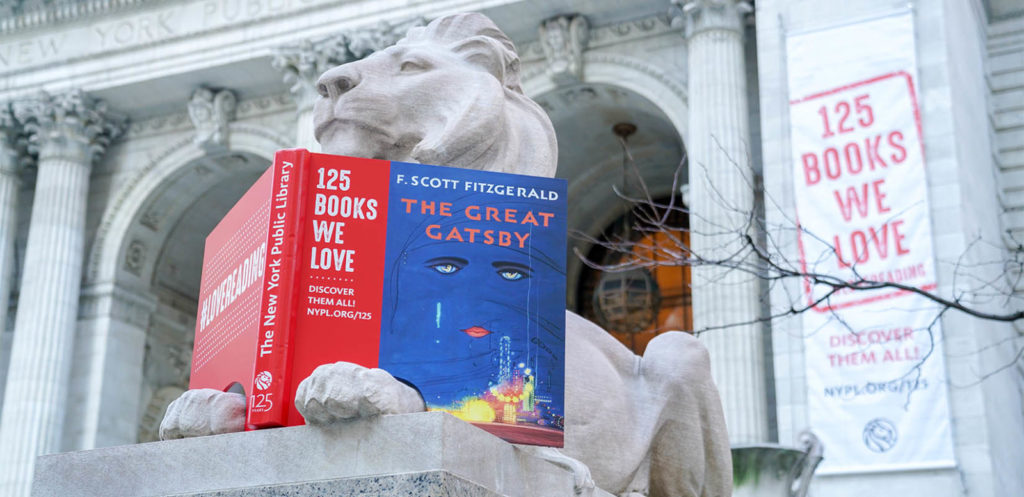 Fortitude outside New York Public Library reading The Great Gatsby.
Fortitude outside New York Public Library reading The Great Gatsby.